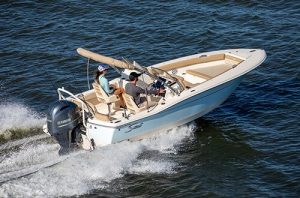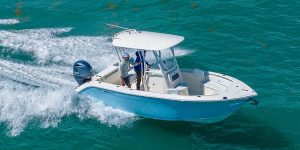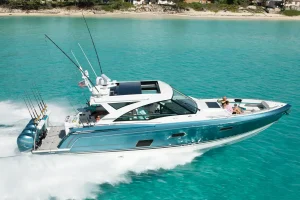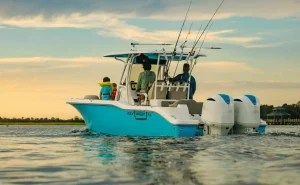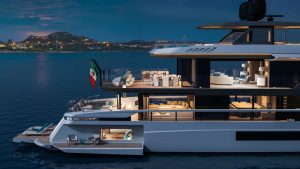Classic Boats: The Ultimate Reference Guide for Enthusiasts and Collectors
Classic boats hold a special place in the hearts of boating enthusiasts, as they represent a bygone era of craftsmanship and design. These timeless vessels capture the imagination with their elegant lines and exquisite interior details. In this ultimate reference guide, we will delve into the fascinating world of antique and classic boats, offering practical advice and insights on what to know before buying, maintaining, and enjoying these unique pieces of maritime history.
The world of classic boats encompasses a wide range of vessel types and materials, from wooden Chris-Craft and Riva launches to 1970s fiberglass Lido 14 sailboats, with each offering its own unique charm and appeal. As the Antique & Classic Boat Society categorizes them, boats built prior to 1918 are considered Historic, between 1919-1942 are Antique, 1943-1975 are Classic, and 1976-1995 are deemed Late Classic. Collectors and enthusiasts appreciate these rarities for their intricate designs and the stories they carry along with their journey through time.
However, owning a classic boat is not without its challenges, and prospective buyers should be aware of the potential pitfalls and necessary care involved in maintaining these gems of the past. In this guide, we will cover the key aspects of classic boat ownership, such as sourcing, restoration, maintenance, and valuation, drawing on expert advice and resources to help ensure your journey into classic boating is a memorable and enjoyable experience.
History of Classic Boats
The history of classic boats can be traced back to ancient civilizations such as Sumer, Egypt, and the Indus Valley, where boats played a crucial role in trade and transportation between 4000 and 3000 BC. As time progressed, boat designs and materials evolved, and some names became synonymous with classic boats.
Evolution of Boat Designs
Boat designs have evolved significantly over the centuries, with early boat models being discovered at various Indus Valley archaeological sites. The shift from sailing ships to steam-powered vessels in the 19th century marked a major shift in boat design. Classic wooden boats, which came into the picture during this time, are a perfect example of the confluence of tradition and innovation. These boats encompass a range of styles, from utilitarian workboats to elegant pleasure crafts.
Famous Builders: Chris-Craft, Century, Gar Wood, Hacker
Several boat builders have become synonymous with the manufacturing of classic wooden boats. Among these are Chris-Craft, Century, Gar Wood, and Hacker.
Chris-Craft: Founded in 1924, the Chris-Craft Corporation became known for its high-quality handcrafted wooden boats. Their motor yachts and launches were admired for their craftsmanship, speed, and elegance.
Century: Established in 1926, Century Boat Company initially produced high-quality wooden boats, later transitioning to fiberglass as the preferred boat-building material. Notable models of Century wooden boats include the Arabian and the Coronado.
Gar Wood: The Gar Wood Industries company, founded by Garfield Wood, became renowned for their wooden boats in the early 20th century. Wood himself was an accomplished speedboat racer, and his company emphasized speed and performance in their boat designs.
Hacker: The iconic Hacker-Craft wooden boats owe their origins to John L. Hacker. With a career spanning more than 50 years, Hacker became a respected name in the field of marine design, which included making sleek and luxurious wooden boats.
These builders have contributed significantly to the history of classic boats, creating timeless designs that capture the essence of boating's legacy.
Identifying Classic Boats
Classic boats are characterized by their unique styling, craftsmanship, and materials used. They are usually categorized as antique, classic, or vintage depending on their age and features. Understanding their characteristics and distinctive features will help enthusiasts and collectors better identify and appreciate these timeless pieces.
Characteristics of Classic Boats
Classic boats are typically classified based on their age, with the period from 1919 to 1942 being considered antique boats, and those built between 1943 and 1975 referred to as classic boats. Additionally, boats built between 1976 and 1995 are often labeled as late classic boats, though the term "vintage boats" is also commonly applied to vessels within these time frames, especially when they have been restored to their original condition or replicated with authentic materials and craftsmanship[1].
While classic boats are often wooden, they can also be made of other materials such as fiberglass[2]. These boats are usually sought after for their timeless style, quality of materials, and attention to detail. Furthermore, they often possess unique features specific to their era, such as mahogany planking, brass fittings, and intricate woodworking.
Styling and Craftsmanship
The styling and craftsmanship of classic boats vary greatly depending on the era and boat type. Wooden boats, for instance, often showcase intricate woodworking and joinery techniques that exemplify the skill and expertise of their builders. This may include dovetail joints, mortise and tenon connections, and the use of wooden pegs known as treenails. The brightwork, or varnished woodwork, is also a distinguishing characteristic of wooden classic boats, with highly polished and maintained surfaces being highly prized by collectors.
In contrast, fiberglass classic boats, such as a 1970s Lido 14 sailboat, may feature more modern lines and finishes, while still maintaining the distinct character of their respective periods. Additionally, these boats may incorporate a combination of materials, such as teak decking, stainless steel fittings, or colorful gelcoat finishes[2].
Classic boats, regardless of their construction material, often possess unique styling cues and design features that set them apart from their modern counterparts. Some of these features might include:
- Retro paint schemes and color combinations
- Classic logos, decals, or emblems
- Traditional sail and rigging designs, such as gaff rigs
- Antique hardware, such as cleats, chocks, and winches
- Classic engine models and mechanical systems
In conclusion, identifying classic boats involves a keen eye for styling and craftsmanship, as well as a thorough understanding of the era's characteristic features. These vessels are celebrated for their timeless appeal and the traditions they represent, from the intricate woodworking of antique wooden boats to the sleek lines and materials of classic fiberglass boats.
Types of Classic Boats
Classic boats come in various forms, each with its historical significance and unique characteristics. In this section, we'll explore three main categories: Sailboats, Powerboats, and Specialty Boats.
Sailboats
Classic sailboats are typically characterized by their timeless design and elegant craftsmanship. These boats are driven by the wind, using sails and a keel or centerboard for stability. Some common types of classic sailboats include:
- Victorian work boats: Rugged and versatile, these boats were used for various tasks in the 19th century.
- Metre boats: Built for racing, these sleek sailboats were popular during the America's Cup championships.
- 1950s "everyman" yachts: These affordable and accessible yachts were popular during the mid-20th century and can still be seen on the water today.
Powerboats
Classic powerboats are motorized vessels that often feature beautifully finished wooden decks and accents. According to Quicknav, these boats often date back to the mid-20th century or earlier. Some examples of classic powerboats include:
- Antique Chris-Craft launches: Built in the 1940s, these wooden powerboats are known for their mahogany construction and elegant design.
- Early fiberglass boats: Produced in the 1960s and 1970s, these boats showcase the first generation of fiberglass materials in boat construction.
Specialty Boats
Beyond the sailboats and powerboats, there are more unique variations of classic boats that hold a special place in boating history. Some examples of specialty boats include:
- Racing boats: These high-performance vessels were specifically designed for speed and featured streamlined hulls and powerful engines.
- Paddle boats and canoes: These human-powered boats often feature oars for propulsion and may have been used for leisure or transportation purposes.
In summary, the world of classic boats includes a wide array of vessel types, each contributing to the rich history and tradition of boating. Whether for sailing, power, or specialized use, these timeless boats captivate enthusiasts with their elegance and craftsmanship.
Classic Boat Shows and Organizations
Classic boats have a rich history and a passionate community of enthusiasts. This section of the ultimate reference guide focuses on classic boat shows and organizations that celebrate, preserve, and promote the enjoyment of these beautiful watercraft.
Major Boat Shows
The Worldwide Classic Boat Show is a significant annual event in the world of classic boats. The next edition is scheduled for February 16-25, 2024, and offers participants the opportunity to explore organizations and boats for sale all year. The show also features virtual presentations and video events, making it accessible to a global audience.
Clubs, Societies, and Associations
There are several clubs, societies, and associations dedicated to preserving, restoring, and enjoying classic boats. Some of these organizations include:
- Antique and Classic Boat Society (ACBS) - Founded in 1975, the ACBS is the largest society in the world dedicated to the preservation and enjoyment of classic boats, including wood, fiberglass, and metal boats.
- Antique Boat America - A marketplace for classic boats and also offers restoration services, storage, transport, financing, and insurance for classic boats.
- Antique Boat Center - A full-service marina that specializes in selling, restoring, and maintaining classic boats.
- Chris-Craft Antique Boat Club - Founded in 1976, it is the world's largest club specifically devoted to classic Chris-Craft boats, offering resources, events, and camaraderie for Chris-Craft enthusiasts.
These organizations often hold annual events and gatherings, such as the ACBS chapters, which organize more than 100 antique boat shows, workshops, cruises, and social events throughout North America. These events cater to enthusiasts with varying interests, providing opportunities to meet like-minded individuals and learn more about the history and beauty of classic boats.
Finding, Purchasing, and Financing Classic Boats
Brokers and Dealers
There are various brokers and dealers specializing in antique and classic boats that can help you find the perfect vessel. Websites like boats.com and BoatDealers.ca offer a wide selection of antique and classic boats for sale, providing detailed information and resources for researching and shopping.
Purchasing Considerations
When looking for a classic boat, it's important to consider the age and condition of the vessel. The Antique & Classic Boat Society classifies boats into five categories based on age (source):
- Historic Boats: Prior to 1918
- Antique Boats: 1919-1942
- Classic Boats: 1943-1975
- Late Classic Boats: 1976-1995
While brands like Chris-Craft or Riva have increased in value over the last two decades, finding a fair valuation can be difficult due to fluctuations in prices and lack of comparable sales (source). It's crucial to arrange a sea trial for any boat you're considering purchasing to identify potential issues such as leaks, smoke, or creaking noises (source).
Financing and Insurance Options
Financing and insuring a classic boat can be more challenging than with a modern vessel, as many lenders and insurers are reluctant to work with these types of boats. Therefore, you may need to seek custom financing and insurance options (source). When looking for financing, it's essential to research and compare various lenders to find the most suitable loan terms for your specific needs. Additionally, contacting specialized insurance providers for classic and antique boats can help you secure coverage that's tailored to your vessel.
Maintenance, Restoration, and Storage
Maintaining a Classic Boat
Proper maintenance is crucial to preserving the beauty and functionality of classic boats. Regular cleaning, inspection, and repair work can help prolong the life of your vessel, be it wooden or fiberglass. Wooden boats, in particular, require special attention to prevent rot, water damage, and other common issues.
When maintaining a classic boat, it is important to inspect its various components such as the hull, deck, and hardware regularly. Pay close attention to potential leaks, damage to the finish, and any signs of rot. Addressing issues promptly can prevent further deterioration and costly repairs in the future.
Restoration Techniques and Guidelines
Restoration projects for classic boats can be rewarding and challenging, requiring a mix of woodworking, finishing, and mechanical skills. Before starting any restoration work, it's crucial to gather proper tools and materials to achieve successful results.
The Big Book of Wooden Boat Restoration by Thomas Larsson is an excellent resource that provides a comprehensive guide to the art of restoring wooden boats. It offers practical tips, expert advice, and time-tested techniques for those looking to embark on their own restoration projects.
For fiberglass boats, meticulous work is required when repairing cracks, chips, and other forms of surface damage. A thorough inspection of the boat's condition should be carried out before embarking on any restoration work, which might include repainting, re-gelcoating or even replacing sections of the boat.
Storage Solutions and Tips
Proper storage plays a vital role in keeping classic boats in good shape. When storing your boat, protecting it from the elements, moisture, and pests is essential to prevent damage and preserve its finish.
Neighbor blog provides some valuable tips on boat storage solutions. Indoor storage is the ideal choice when it comes to protecting your boat from harsh weather conditions, sunlight exposure, and potential theft. However, if indoor storage is not an option, a high-quality boat cover and a secure outdoor storage location can offer reasonable protection.
Additionally, proper winterization, which includes draining fluids and removing the battery, is a crucial storage tip for classic boats to ensure their readiness for the next boating season.
Resources, Publications, and Media
There are several resources available for those interested in learning more about classic boats, from books and magazines to online resources. Each has its benefits and can provide unique insights, historical perspectives, and valuable expertise on the subject.
Books and Magazines
A number of publications have been dedicated to classic boats, covering various aspects of their design, history, and restoration. One popular magazine is Classic Boat, which features articles on maritime history, profiles of classic boats and owners, restoration tips, and more. The magazine also offers a comprehensive index of its back issues, making it an easy-to-use reference source for enthusiasts.
Another noteworthy publication is the Hagerty Classic Boat Price Guide, which is the first-ever of its kind. This guide classifies boats into four value ranges and provides updated values on a regular basis. It is an invaluable resource for those interested in collecting or investing in classic boats.
Furthermore, there are several books available that cover various aspects of classic boats, such as their history, design, and restoration techniques. These books can be found in bookstores, libraries, and online marketplaces.
Online Resources
There are many online resources that provide valuable information on classic boats. For example, everythingaboutboats.org offers a wealth of content on the early history of boats and serves as an ultimate reference resource for boaters. It features detailed articles, directories, and links to other sources of information on classic boats and their history.
Another useful online resource is the PowerBoat Guide, which focuses on late-model motoryachts, cruisers, and fishing boats. This guide contains a vast collection of boating information and is considered one of the most quoted publications in the business. It is a valuable tool for brokers, collectors, and enthusiasts alike.


